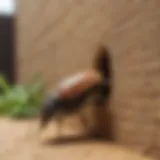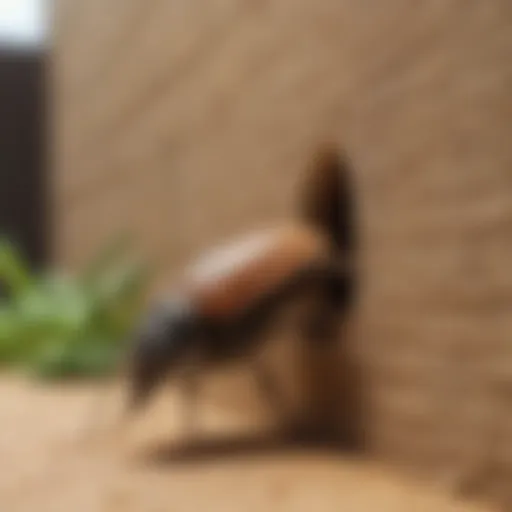Effective Strategies for Removing a Cricket in the Wall and Ensuring Peaceful Living
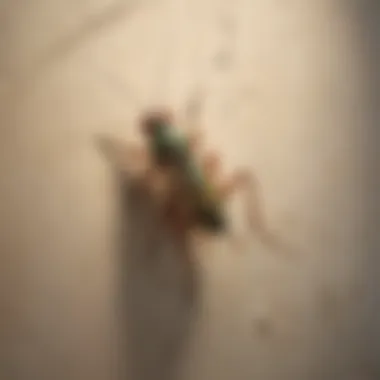

Preventive Pest Control Strategies
When addressing pest issues within your home, it is paramount to implement preventive pest control strategies to establish a secure environment for your family. Beginning with safeguarding the exterior of your house, focus on sealing cracks effectively to impede the entry of pests such as crickets 🦗 by using high-quality sealants. By eliminating potential entry points, you create a barrier against unwanted intruders. Simultaneously, clearing out debris from the surroundings of your house ensures that pests are deprived of hiding spots, reducing the risk of infestations.
To fortify your defense against pests, prioritize yard maintenance by adhering to essential yard care routines. Regularly mowing the lawn and trimming bushes not only enhance the aesthetics of your property but also deter pests from nesting in unkempt areas. Incorporate methods like using natural pest repellents to further prevent pests from harboring in your yard. By maintaining a well-kept outdoor space, you significantly diminish the likelihood of cricket invasions.
Indoor cleanliness plays a significant role in pest control. Experts recommend adopting meticulous cleaning techniques to eliminate crumbs, spills, and potential insect attractants. By denying pests access to food sources, you actively discourage their presence within your living spaces. Moreover, implementing a pest-resistant indoor environment through regular cleaning practices and proper waste disposal reduces the allure of your home to crickets and other nuisances.
Effective garbage disposal is indispensable in pest control efforts. Implement efficient waste disposal methods by securely sealing trash bags and utilizing lidded bins to deter pests from scavenging for food remnants. Proper garbage disposal not only mitigates the risk of attracting crickets and other pests indoors but also contributes to maintaining a hygienic living environment that is unwelcoming to unwelcome critters.
Furthermore, explore innovative pest prevention strategies to safeguard your home comprehensively. Consider incorporating tactics such as installing door sweeps, utilizing ultrasonic pest repellents, and implementing neem oil solutions to create a hostile environment for pests. By combining these preventive measures, you establish a formidable defense against crickets and other potential intruders.
Identifying Pest Risk Areas
In the pursuit of effective pest control, the identification of pest risk areas is paramount to proactively address potential infestations. Conduct thorough inspections of moisture-prone areas within your home to detect damp conditions that attract pests. By promptly fixing leaks, addressing ventilation issues, and reducing humidity levels in susceptible areas, you can mitigate the risk of cricket infestations.
A critical component of pest management involves inspecting cracks and crevices, which serve as common entry points for pests like crickets. Regularly assess these access points, sealing them with appropriate materials to prevent unwanted intrusions. By employing silicone-based caulk or weatherstripping to seal crevices, you establish a formidable barrier against pests, safeguarding your home effectively.
Greenery inspection is also essential in identifying pest risks, as dense vegetation can harbor insects and provide shelter for crickets. Prune overgrown shrubs, remove decaying plant matter, and maintain proper landscaping practices to minimize conducive environments for pests. Additionally, consider implementing natural remedies like diatomaceous earth or garlic spray to deter pests from colonizing your yard.
Apart from these key areas, remain vigilant for miscellaneous pest risk zones that may vary based on your geographical location and property type. Explore specific preventive measures tailored to these unique risk areas to fortify your defenses comprehensively against potential cricket invasions.
Effective Pest Control Methods
To combat existing pest issues, a multifaceted approach utilizing various pest control methods is essential in achieving optimal results. Harness the power of natural repellents derived from essential oils, herbs, and plants to deter pests like crickets from residing in your home. Popular options like peppermint oil, lavender sachets, and cedar blocks serve as effective deterrents, infusing your living spaces with pleasant scents while repelling unwanted visitors.
For more escalated pest situations, chemical sprays can be employed judiciously to eradicate pests effectively. Take care to follow safety protocols and usage guidelines when utilizing professional sprays, ensuring the protection of both your household members and the environment. Chemical sprays provide a targeted approach to eliminating pests, offering swift relief from infestations while minimizing potential harm.
Incorporating pest traps into your pest control arsenal offers a non-toxic yet effective solution for capturing and removing pests such as crickets. Strategically place traps in areas prone to pest activity, opting for humane traps that allow for the safe relocation of captured insects. By regularly monitoring and replacing traps, you can effectively reduce cricket populations within your home.
An eco-friendly alternative to chemical solutions is biological control methods, which leverage natural predators to manage pest populations sustainably. Introduce beneficial insects like ladybugs or lacewings to your garden to combat pests like aphids, mitigating the need for harsh chemicals. By supporting natural ecosystems through biological pest control, you cultivate a harmonious balance that minimizes the presence of crickets and other pests.
Explore other innovative pest control methods beyond traditional approaches to address unique pest challenges effectively. From utilizing ultrasonic pest repellers to employing insect growth regulators, there exists a myriad of cutting-edge solutions to combat pests while minimizing environmental impact.
Pest Species Identification


Identifying common pests prevalent in home environments is instrumental in devising targeted pest control strategies tailored to specific species. Insects such as ants, cockroaches, and spiders are common household nuisances that necessitate proactive management to prevent infestations. Learn to recognize the distinctive features and behaviors of these insects to implement tailored control measures that address their unique characteristics.
When combating rodent infestations, proper identification of rodent species like mice and rats is crucial in employing effective prevention techniques. Seal entry points that rodents exploit and implement rodent-proofing measures to curtail their access to indoor spaces. By understanding the habits and vulnerabilities of rodent species, you can devise targeted strategies to deter their presence and safeguard your home against infestations.
In addition to insects and rodents, certain bird species can impact home environments negatively, necessitating proactive measures to address avian-related issues. Identify troublesome bird species in your area and implement deterrent measures such as visual deterrents, netting, or sound repellents to discourage their presence around your property. By creating bird-resistant barriers and modifying your environment, you can minimize conflicts with birds and preserve the integrity of your home.
Managing encounters with wildlife species requires a nuanced approach that prioritizes safety and humane deterrent methods. Educate yourself on the behavior patterns and habitat preferences of wildlife species that frequent your area to minimize potential conflicts. By implementing non-lethal mitigation techniques and securing potential entry points, you can peacefully coexist with wildlife while safeguarding your property from encroachments.
Beyond conventional pests, there exist lesser-known pest species that may pose challenges in home environments. Familiarize yourself with the characteristics and habits of these obscure pests to effectively manage infestations. Employ targeted control methods and preventive measures to address these unique pest species, maintaining a pest-free home environment.
DIY Pest Control Techniques
Embarking on do-it-yourself (DIY) pest control endeavors empowers homeowners to tackle pest issues using cost-effective and environmentally friendly solutions. Utilize homemade pest control remedies crafted from everyday household items to combat common pests without resorting to chemical-laden products. Ingredients like vinegar, baking soda, and essential oils can be combined to create potent pest deterrents that are safe for both occupants and pets.
Harness the natural repellent properties of essential oils to fend off pests like crickets and create a bug-free environment within your home. Essential oils like eucalyptus, citronella, and tea tree oil serve as potent insect repellents, infusing your living spaces with refreshing scents while deterring unwanted intruders. By incorporating essential oils into your cleaning routines and DIY pest control solutions, you can enjoy a naturally pest-resistant home environment.
Implementing effective pest traps and barriers is a proactive measure against pest incursions, preventing pests from accessing vulnerable areas within your home. Strategically position traps near entry points, windows, and other pest entryways to capture unwanted insects while minimizing their presence indoors. Additionally, install physical barriers like door sweeps and window screens to fortify your home against pests and maintain a secure living environment.
Explore reputable pest control brands that offer quality products for managing pests effectively within your home. Select products from trusted brands renowned for their efficacy in pest control, ensuring that you invest in solutions that deliver optimal results. By utilizing reputable pest control brands, you can rest assured that your pest management efforts are backed by industry-leading expertise and innovation.
Incorporate miscellaneous DIY pest control techniques tailored to address specific pest issues that you encounter in your home. From crafting homemade ant baits to repelling mosquitoes using natural remedies, explore a diverse range of DIY methods to combat pests effectively. By proactively addressing pest issues through innovative solutions, you can maintain a pest-free home environment conducive to your well-being and comfort.
Understanding the Presence of a Cricket in the Wall
Embarking on the journey to comprehend the cryptic activity of a cricket hidden within the sanctity of your wall represents a crucial endeavor in the realm of household intervention and pest management. The pertinence of this undertaking lies in unraveling the enigma behind the unseen yet audible disturbances that disrupt the tranquil tapestry of domestic life. By delving into the realms of chirping echoes and cryptic traces left behind, one can equip oneself with the knowledge necessary to address this clandestine intrusion effectively and expeditiously.
Identifying the Signs of a Cricket in the Wall
- Chirping Noises: The pervasive allure of the incessant chirping emanating from within the confines of the wall serves as a telltale sign of the elusive cricket's presence. This auditory manifestation, although seemingly subtle, underscores the urgent need for intervention, as silence is the melody of unmarred habitat.
- Visible Damage to Walls: The insidious impacts of the cricket's residency manifest themselves in the form of imperceptible yet discernible architectural deterioration. Through keen observational acumen, one can discern the subtle nuances of structural compromise brought forth by the cricket's inhabitation within the walls, signaling a call to action.
- Fecal Droppings: The visceral evidence left behind by the stealthy insect in the form of fecal deposits symbolizes a bodily relic that not only compromises the aesthetic integrity of the abode but also poses potential health hazards, necessitating immediate mitigation measures.
- Sightings of Crickets: A visual encounter with the elusive cricket, though scarce, serves as a definitive validation of its infiltration. By honing one's ability to identify these elusive creatures, a significant step towards eradication and prevention is achieved.
Reasons for Crickets in the Wall
- Seeking Shelter: The inherent proclivity of crickets towards seeking refuge in the crevices and cavities of walls stems from an intrinsic need for seclusion and protection. Understanding this behavioral tendency is paramount in formulating effective strategies to dissuade their residency within domestic confines.
- Attracted to Light Sources: The magnetic allure of luminous beacons acting as a siren song for crickets underscores the need to strategically manipulate light sources as a means to deter and displace these insidious intruders.
- Availability of Food Sources: The prevalence of viable sustenance within the proximity of walls serves as a compelling factor drawing crickets towards residential structures. By mitigating and controlling food accessibility, one can disrupt the delicate ecosystem supporting their existence within the confines of the abode.
Non-Invasive Methods to Remove a Cricket
When tackling the persistent presence of a cricket within your walls, opting for non-invasive methods holds significant importance. These strategies offer a way to address the issue without causing damage to your property or using harmful chemicals, thereby ensuring a safe and environmentally friendly approach to eliminating the cricket infestation. By incorporating non-invasive methods, you can effectively deal with the problem while maintaining the integrity of your home's structure.
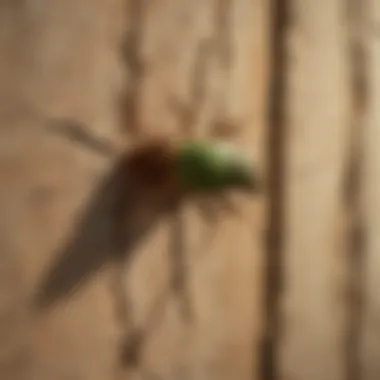

Using Traps and Lures
Glue traps
Diving into the realm of glue traps unveils a practical solution to capturing crickets within the confines of your walls. The adhesive nature of these traps proves instrumental in ensnaring the unsuspecting insects as they navigate through tight spaces. Their simplicity lies in their effectiveness, making glue traps an attractive option for those seeking a straightforward and hassle-free means of pest control. While their efficacy in trapping crickets is undisputed, it's essential to handle them with care to prevent unintended contact with humans and pets, mitigating potential risks associated with their application.
DIY traps with food bait
Envision a scenario where homemade traps adorned with enticing food baits lure crickets out of their wall sanctuary, offering a DIY approach to pest management. The strategic concoction of food-based attractants beckons the crickets towards the trap, successfully coaxing them out of their hiding spots. Harnessing the power of common household items, these traps present a cost-effective and convenient alternative to store-bought solutions, aligning well with the resourceful homeowner's quest for practical pest removal methods. However, while DIY traps with food bait showcase ingenuity, their efficacy may vary based on the bait used and the placement of the traps.
Ultrasonic repellents
Venturing into the domain of ultrasonic repellents introduces a technology-driven tactic to deter crickets from your walls. Emitting high-frequency sound waves imperceptible to human ears, these electronic devices create an uncomfortable environment for crickets, prompting them to seek refuge elsewhere. The non-intrusive nature of ultrasonic repellents makes them an attractive option for individuals averse to traditional trapping methods or chemical interventions. Yet, it's important to note that the effectiveness of these repellents may be influenced by factors such as room layout and the presence of obstacles that could impede the sound waves' propagation, necessitating strategic placement for optimal results.
Creating Disturbances to Encourage Cricket Exit
Loud noises
Integrating loud noises into your strategy to evict crickets from the walls serves as a disruptive yet effective method to coax the chirping insects out of their hiding spots. The sudden intrusions of sound disrupt the crickets' sense of security, prompting them to flee the acoustic assault and seek refuge in quieter surroundings. This unconventional approach highlights the versatility of pest removal tactics, showcasing how audible disruptions can serve as a powerful tool in disrupting the crickets' peace and encouraging their departure.
Increasing light intensity
Adjusting the lighting conditions within your home to brighter levels emerges as a straightforward yet compelling technique to nudge crickets out of their wall abode. The intensified luminosity disorients the crickets, compelling them to venture out in search of darker, more comforting environments. By leveraging light as a natural repellent, you can capitalize on the insects' phototactic instincts, guiding them towards exits and away from the shelter of your walls. This method taps into the innate behaviors of crickets, harnessing their light-sensitive tendencies to expedite their evacuation from your living spaces.
Temperature fluctuations
Manipulating the ambient temperature to create fluctuations presents a nuanced approach to encouraging crickets to vacate your walls. The alteration between warm and cool conditions introduces an element of discomfort for the insects, prompting them to seek stability in temperature-controlled niches beyond the confines of your residence. This method not only exploits the crickets' sensitivity to temperature changes but also underscores the adaptability of pest removal strategies rooted in environmental cues. By incorporating temperature as a disruptive element, you can coax the crickets out of their comfort zone and guide them towards an exit strategy, facilitating their exit from your property.
Invasive Methods for Dealing with Stubborn Crickets
Dealing with stubborn crickets can be quite a challenge, requiring more aggressive techniques to ensure effective removal from the walls. Invasive methods play a crucial role in this process, aiming to eliminate the cricket infestation efficiently. These methods delve deeper into the structure of the wall to target the crickets directly, making it a key component of this article on effective strategies for cricket removal.
Drilling and Dusting
When it comes to invasive methods for dealing with stubborn crickets, drilling small holes in the walls is a widely used approach. This method entails creating small openings in the wall structure to access the hidden areas where crickets dwell. By drilling these holes strategically, it becomes possible to apply insecticidal dust directly into the wall voids, effectively targeting the crickets where they hide. The key characteristic of drilling small holes lies in its precision targeting of the affected areas, ensuring a focused application of insecticide for maximum impact. While drilling can be a successful method for addressing stubborn cricket infestations, it's essential to consider the potential drawbacks, such as structural damage that may occur if not done carefully.
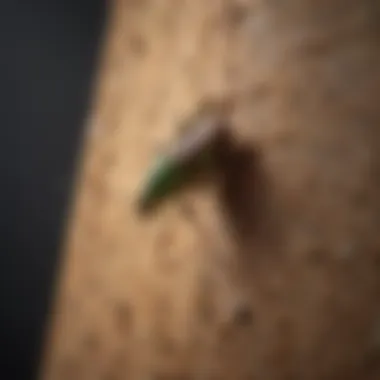

Injecting Insecticidal Dust
Injecting insecticidal dust into the walls is another effective technique for combating persistent cricket infestations. By using specialized equipment to blow the insecticidal dust into the drilled holes, this method reaches deep into the wall voids where crickets typically reside. The unique feature of injecting insecticidal dust lies in its ability to treat inaccessible areas within the wall, ensuring comprehensive eradication of crickets. While this approach offers significant advantages in terms of targeting hidden cricket populations, it's important to note the potential disadvantages, such as the need for professional expertise to handle the insecticide safely and effectively.
Hiring Licensed Exterminators
Turning to professional pest control services for dealing with stubborn crickets can provide a highly specialized and efficient solution. Licensed exterminators bring expertise and experience to the table, offering a thorough assessment of the cricket infestation and tailored treatment strategies. The key characteristic of hiring licensed exterminators is their in-depth knowledge of pest behavior and effective pest control methods, ensuring targeted and lasting results. While this option presents numerous benefits in terms of expertise and efficacy, homeowners should be aware of the associated costs and the importance of selecting reputable pest control professionals.
Use of Specialized Equipment
In conjunction with professional services, the use of specialized equipment can significantly enhance the effectiveness of cricket removal efforts. Advanced tools and technologies, such as infrared cameras and acoustic sensors, allow exterminators to pinpoint cricket locations within the walls accurately. The unique feature of using specialized equipment is its ability to detect and address cricket infestations with precision, leading to faster and more efficient removal processes. While this approach offers undeniable advantages in terms of targeted treatment and efficiency, homeowners should consider the added costs associated with employing specialized equipment for pest control.
Preventive Measures to Avoid Future Cricket Infestations
Preventive measures play a pivotal role in maintaining a pest-free environment. By implementing strategies to deter crickets from re-infesting your walls, you ensure long-lasting relief from these bothersome creatures. Emphasizing preventive measures not only addresses the current issue but also acts as a barrier against future infestations, fostering a more peaceful living space for you and your family.
Sealing Entry Points
Caulking Cracks and Gaps
Caulking cracks and gaps is a fundamental step in fortifying your home against unwanted intruders like crickets. This method involves using a sealant to fill in any openings or crevices in walls, floors, or ceilings where crickets can gain entry. The primary advantage of caulking is its ability to create a physical barrier that inhibits pest access. While caulking requires precision and attention to detail, its effectiveness in sealing off potential entry points makes it a popular choice for homeowners seeking long-term pest control solutions.
Installing Door Sweeps
Installing door sweeps involves affixing a strip of material to the bottom of doors to block small gaps that could serve as entry points for crickets. Door sweeps act as a simple yet effective line of defense, preventing pests from sneaking indoors through gaps beneath doors. One key characteristic of door sweeps is their ease of installation, making them a convenient choice for individuals looking to bolster their home's defenses against invasive insects. The presence of door sweeps also enhances energy efficiency by minimizing heat loss or gain through gaps.
Repairing Damaged Screens
Repairing damaged screens on windows and doors is crucial in preventing crickets from entering living spaces. Damaged screens can serve as entry points for a variety of pests, including crickets. By promptly repairing any holes or tears in screens, you not only prevent cricket infestations but also improve overall indoor air quality. The unique feature of repairing screens lies in its dual functionality of safeguarding against pests and enhancing ventilation. While minor repairs can be DIY tasks, significant damage may require professional intervention but ensures long-term protection against unwanted intrusions.
Maintaining Cleanliness and Hygiene
Regular Cleaning Routines
Regular cleaning routines are essential in reducing factors that attract crickets, such as food crumbs and moisture. By regularly cleaning floors, countertops, and other surfaces, you eliminate potential food sources for crickets, discouraging their presence in your home. The key characteristic of regular cleaning lies in its proactive approach to pest management, creating an inhospitable environment for crickets to thrive. While time-consuming, the advantages of regular cleaning extend beyond pest control to promoting a healthy and tidy living space.
Proper Food Storage
Proper food storage is critical in denying crickets access to readily available food sources. By storing food items in tightly sealed containers, you not only prevent contamination but also deter pests like crickets from foraging in your kitchen. The unique feature of proper food storage is its direct impact on pest behavior, forcing them to seek nourishment elsewhere. While the initial investment in airtight containers may seem high, the long-term benefits of avoiding pest infestations justify the cost.
Reducing Moisture Levels
Reducing moisture levels in your home is paramount in creating an unwelcoming environment for crickets. Crickets are attracted to damp areas, making moisture control a crucial aspect of pest prevention. By employing dehumidifiers, fixing leaks, and promoting good ventilation, you inhibit the conditions conducive to cricket infestations. The key characteristic of moisture reduction is its multi-faceted approach to pest management, addressing not only crickets but also other moisture-loving pests. While maintaining optimal moisture levels requires ongoing vigilance, the advantages of a dry environment extend beyond pest control to overall household comfort and well-being.
